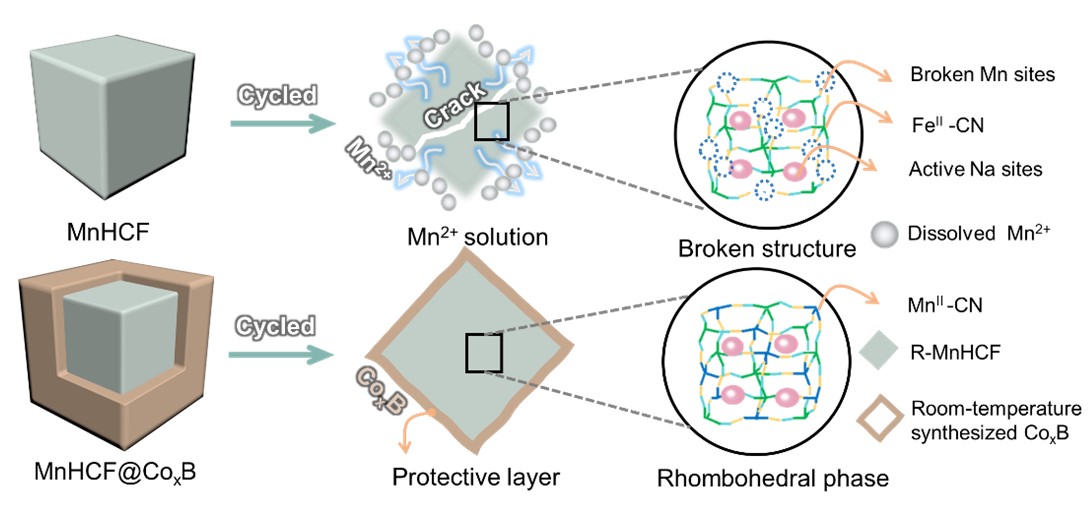The rhombohedral sodium manganese hexacyanoferrates (MnHCF) is regarded as a scalable, low-cost, and high-energy cathode material for Na-ion batteries due to the absence of crystal water.
However, the unexpected Jahn-teller effect and significant phase transformation causes Mn dissolution and anisotropic volume change, leading to capacity loss and structural instability. Thus, it is important to build a robust and full coverage coating on the surface of MnHCF particles to address cycling instability.
A research group led by Prof. ZHAO Junmei from the Institute of Process Engineering (IPE) of the Chinese Academy of Sciences reported a simple room-temperature route to construct a magical CoxB skin on the surface of MnHCF, demonstrating thousands-cycle level cycling lifespan and high energy density close to LiFePO4 for Li-ion batteries.
The study was published in Angewandte Chemie on Jan. 31 (DOI:10.1002/anie.202217761).
"Room-temperature synthesized CoxB seems to be tailor-made as a coating substance of MnHCF cathode," said Prof. ZHAO. "Meanwhile, CoxB is a metallic borate glass, and due to high corrosion and wear resistance, it shows good mechanical flexibility, which is expected to prevent the fracture or fragmentation of cathode particles."
Moreover, CoxB can work as a double conductor of mixed electrons and ions. These unique advantages make the optimal CoxB coated MnHCF cathode (MnHCF-5%CoxB) deliver an initial capacity of ~133 mA h g-1 at 10 C, higher than that of bare MnHCF (~110 mA h g-1).
More importantly, the coated samples can remain a capacity retention of over 80%, far superior to that of the pristine one (41%). In the full-cell configurations, the MnHCF-5%CoxB//HC delivers a high energy density of 310 Wh kg-1 based on the total mass of cathode/anode active substances, which is comparable to the commercial LFP cathode (~330 Wh kg-1).
"MnHCF-5%CoxB//HC shows an impressive capacity retention of ~71% at 5 C after cycling 1000 cycles, which is a significant breakthrough among the nonaqueous MnHCF full cells," said ZHAO.

Figure. Schematic illustration of the proposed protective mechanism of CoxB to suppress the Mn dissolution and generation of microcracks of MnHCF cathode (Image by ZHAO Junmei).
LI Xiangyu
Public Information Officer
Institute of Process Engineering, Chinese Academy of Sciences, Beijing 100190, P. R. China.
E-mail:xiangyuli@ipe.ac.cn
Tel: 86-10-82544826
 Search
Search




 京公网安备110402500047号
京公网安备110402500047号